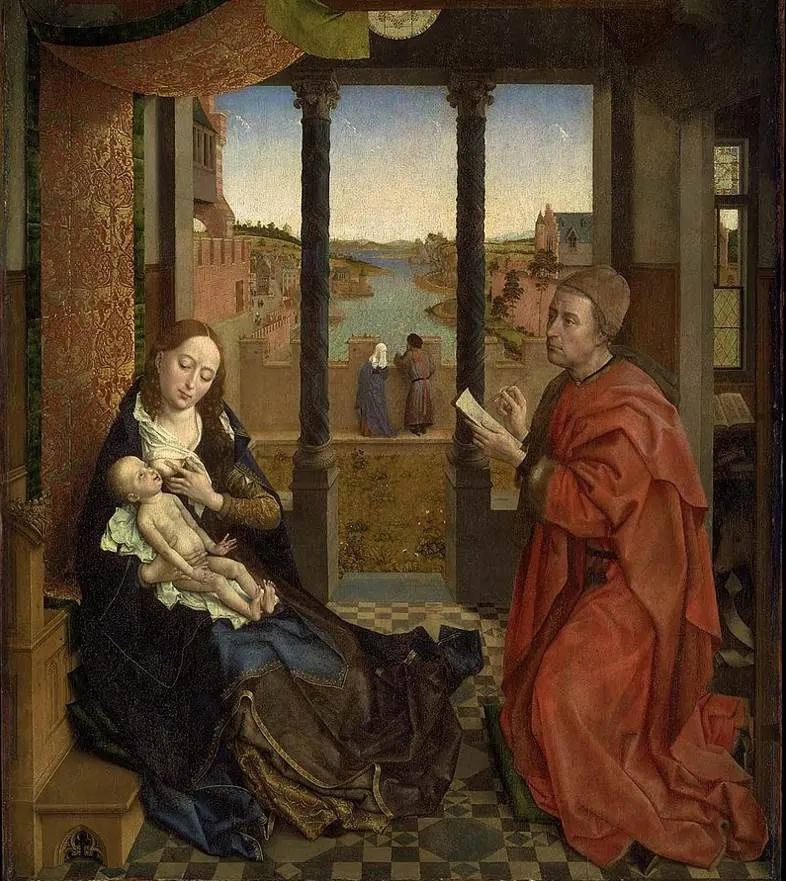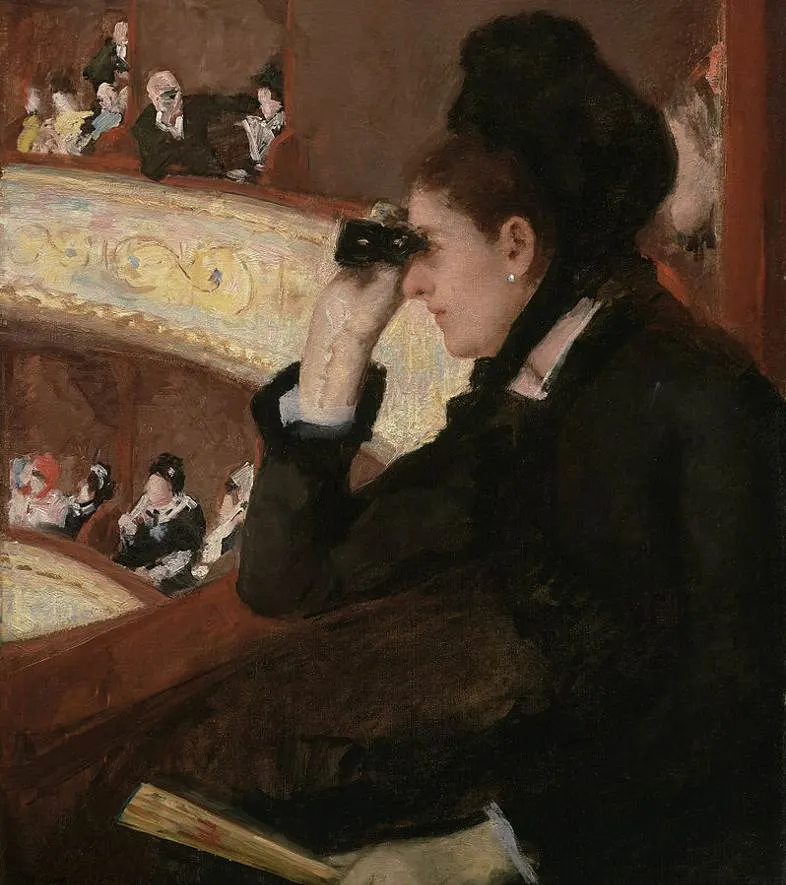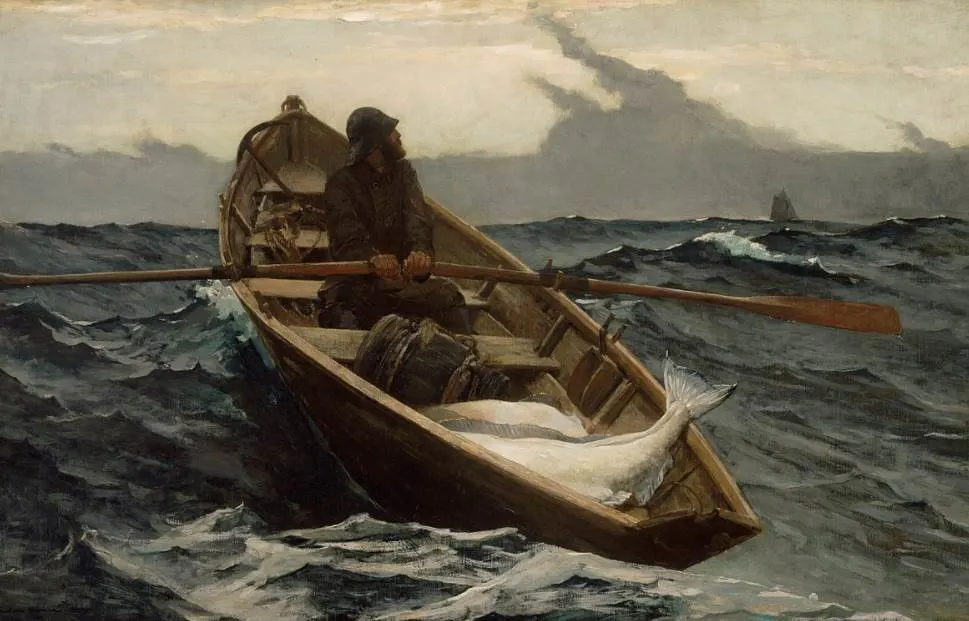One of the most popular art museums on the East Coast of the United States can be found in Boston, Massachusetts.
The Museum of Fine Arts has a collection size of well over 8,000 paintings and over 450,000 works of art. This makes it one of the most extensive collections of any art museum in the Americas.
Established in the 1870s, the museum was housed on the top floor of the Boston Athenaeum initially before being moved to a Gothic Revival-style building in 1876.
As the museum gradually grew, a decision was made to build a new Neoclassical building in the early 20th century. It has been housed here since 1909 and was expanded several times over the century.
With over 1.2 million yearly visitors, it’s a popular museum as well. In this article, you’ll discover some of the most famous paintings at the Museum of Fine Arts in Boston so you’ll understand exactly why.
1. Saint Luke Drawing the Virgin – Rogier van der Weyden
- Date created: 1435-1440
- Dimensions: 137.5 × 110.8 centimeters (54.12 in × 43.2 inches)
Saint Luke Drawing the Virgin is a painting by renowned Flemish artist of the northern Renaissance Rogier van der Weyden. He was a generation younger than his colleague Jan van Eyck (1490-1441) and he was influenced by van Eyck’s works, something clearly emphasized in this painting.
The composition of this magnificent painting is very similar to that of “Madonna of Chancellor Rolin” (1434). The figures are, however, reversed. It’s also fairly certain that the face of Saint Luke is a self-portrait of the artist.

2. The Artist in his Studio – Rembrandt van Rijn
- Date created: 1628
- Dimensions: 24.8 × 31.7 centimeters (9.8 × 12.5 inches)
The Artist in his Studio is a delicate little painting by Rembrandt van Rijn (1606-1669), the Baroque master who is considered to be one of the most famous Dutch artists in history. It was completed when the artist was still in his early twenties and long before he completed some of his most famous masterpieces.
It’s unclear whether or not this is a self-portrait of Rembrandt, one of the nearly 100 that he created during his lifetime. That’s because he highlighted the easel in the foreground of the painting and put the artist in a corner of the studio, covered in shade.

3. Prince Balthasar Charles with a Dwarf – Diego Velázquez
- Date created: 1631
- Dimensions: 128 × 102 centimeters (50 × 40 inches)

Prince Balthasar Charles with a Dwarf is a portrait painting of renowned Spanish artist of the Baroque era Diego Velázquez (1599-1660). It’s one of the many portraits that the artist produced of Balthasar Charles, Prince of Asturias (1629-1646), while he was the court painter of King Philip IV of Spain.
Although the child was only 2 years old at the time this Velázquez painting was completed, the artist still depicted him wearing a captain-general uniform with a commander’s stick in hand. The court dwarf is holding an apple and a rattle, items emphasizing the different status of both figures.

4. Watson and the Shark – John Singleton Copley
- Date created: 1778
- Dimensions: 182.1 × 229.7 centimeters (71.69 x 90.43 inches)
Watson and the Shark is a painting by English-born American artist John Singleton Copley (1738-1815). It depicts the recuse of an English boy named Brook Watson who is being attacked by a shark off the coast of Havana, Cuba.
This event took place in 1749 when the boy was 14 years old and resulted in the amputation of his right leg. despite this, Brook Watson became a politician and Mayr of London later in life. Copley painted 3 versions of the painting and the original is on display at the National Gallery of Art in Washington D.C. A smaller version from 1781 is held at the Detroit Institute of Arts.

5. Modern Rome – Giovanni Paolo Panini
- Date created: 1757
- Dimensions: 172.1 × 233 centimeters (67.25 × 91.25 inches)
Modern Rome is the common name of 3 similar paintings that are officially referred to as Picture Gallery with Views of Modern Rome. They were painted by Italian artist Giovanni Paolo Panini (1691-1765) who became famous for his “Vedute,” paintings depicting picture galleries.
This painting depicts an immense gallery with buildings in Rome at the time of the 18th century. The Paintings at the Museum of Fine Arts in Boston is the original version while the others are held at the MET in New York City and the Louvre in Paris. Panini also painted an accompanying painting called “Ancient Rome” which depicts Rome’s ancient monuments.

6. The Slave Ship – J.M.W. Turner
- Date created: 1840
- Dimensions: 91 × 123 centimeters (36 × 48 inches)
The Slave Ship is one of the most famous paintings by J.M.W. Turner (1775-1851), the Renowned English painter and one of the leading artists of the Romantic era in the 19th century. It’s considered to be a prime example of Romantic maritime paintings.
The work was originally known as “Slavers Throwing overboard the Dead and Dying—Typhon coming on,” a title that pretty much explains what is depicted. It was produced around that strong voices for abolishing slavery were raised all across the world.

7. The Daughters of Edward Darley Boit – John Singer Sargent
- Date created: 1882
- Dimensions: 222.5 × 222.5 centimeters (87.6 × 87.6 inches)
The Daughters of Edward Darley Boit is one of the most fascinating paintings by American artist John Singer Sargent, a man who was not only born in Florence, Italy, to American parents but also spent most of his career in Europe. He was an Impressionist artist who specialized in portraits and is famous for accurately depicting luxurious Edwardian settings.
This painting depicts 4 girls who are the daughters of Edward Darley Boit, an American friend of Sargent who lived in Paris. This painting depicts a room inside the apartment of Boit in Paris. The remarkable composition of the painting might have been influenced by Las Meninas (1656), the most revered work by Diego Velázquez which Sargent admired and had copied before.

8. Grainstack (Sunset) – Claude Monet
- Date created: 1891
- Dimensions: 73.3 x 92.7 centimeters (28.87 x 36.5 inches)
Grainstack (Sunset) is one of the paintings by Claude Monet that is part of a series of paintings with a similar subject. Monet (1840-1926) painted these works near his home in Giverny, the place where he lived during the final decades of his life.
As the founding father of Impressionism, he received critical acclaim because of the remarkable use of light in his paintings. Some art historians assume that he produced these works in the early morning and other times of the day to study the different light patterns that emerged.

9. In the Loge – Mary Cassatt
- Date created: 1878
- Dimensions: 81 × 66 centimeters (32 × 26 inches)
In the Loge is a remarkable work of art by Mary Cassatt (1844-1926), the American artist who moved to Paris and became one of the three great ladies of the Impressionist art movement. It depicts a woman who is staring through opera glasses to get a closer view of the stage inside the auditorium.
The scene takes place at the Palais Garnier, the opulent opera house in Paris which had only been recently completed at the time as it was built between 1861 and 1876. The remarkable detail about this painting is that we can see a man spying on the woman in a box nearby.

10. The Fog Warning – Winslow Homer
- Date created: 1885
- Dimensions: 76 × 122 centimeters (30 × 48 inches)
The Fog Warning is one of the multiple marine paintings produced by renowned American artist Winslow Homer (1836-1910). It’s one of the paintings by Homer that makes it clear why he is considered to be one of the greatest Realism artists in history.
He produced this work after returning from a journey to England between 1881 and 1882 and after permanently settling in Prouts Neck, Maine, a U.S. state in the utmost northeastern part of the country. It depicts a fisherman in Maine and is one of many works that depicts the hard life of fishermen in Maine.

